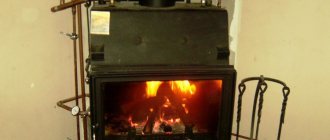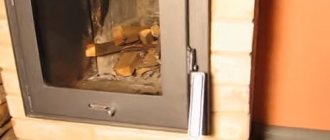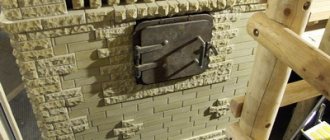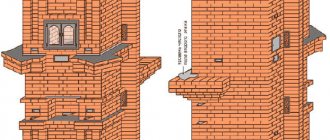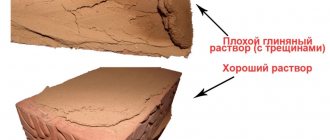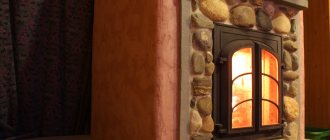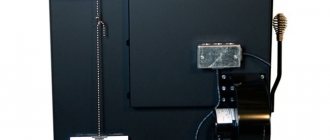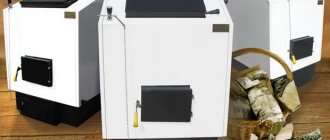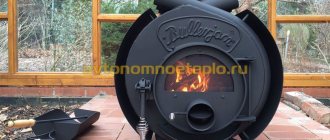- Where to place the stove in the house
- Russian with a high bed
Connecting to central heating is not always possible and economically justified. Especially when it comes to life in a dacha cooperative or a remote village. In such a situation, you can limit yourself to a beautiful brick stove for a private house; photos of the best options are in our article.
The main advantage of this heating option is the use of brick blocks. They accumulate heat and release it over a long period of time. The draft promotes ventilation of the premises, the walls of the building remain dry, which is especially important for wooden cottages.
If this is provided for by the design, you can cook food. Some models provide a special bed for resting and sleeping.
But we should not forget about the negative aspects. In particular, only the rooms directly adjacent to the heating equipment are heated. The further the room is from the firebox, the colder it will be. There is only one way to fix the problem - to equip several units. They may have combined or separate chimneys. If the cottage is compact (according to the five-wall principle), the stove is placed in the central part. From the living rooms one can admire the open brazier; in the kitchen one can cook dinner.
Types of brick stoves for the home - photos
All existing modifications belong to one of the basic variations. They are adjusted, modified in size and shape, taking into account the parameters of the room and the wishes of the customer.
Russian
The main differences from all other variations are the massiveness and the presence of a sleeping place. For pots and pans there is a wide firebox, closed with a damper. The walls are heated by smoke channels of considerable length.
Dutch
You won't be able to cook a roast on it. The main purpose is to heat rooms through special passages from bottom to top.
Heating appliances are relatively small in size. They are chosen by the owners of country houses, including two-story ones. The shape of the unit is not strictly regulated. It can be chosen based on personal preferences. One thing remains mandatory - the height exceeds the width.
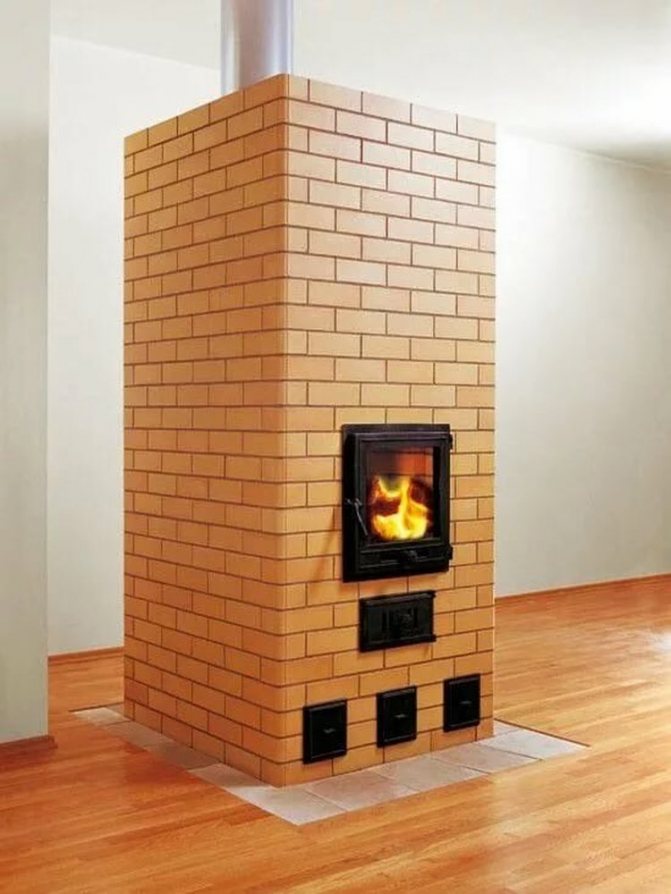
Swede
It is smaller in size than the Dutch one, but in terms of efficiency and versatility it is comparable to the Russian one. You can cook food on it and dry wet shoes in special niches. The Swedish stove is a channel-type stove, but the flue gases burn out under the roof. The design is not intended for large cottages. Its power is only enough for neighboring rooms. Another application is as an addition to a standard heating system.
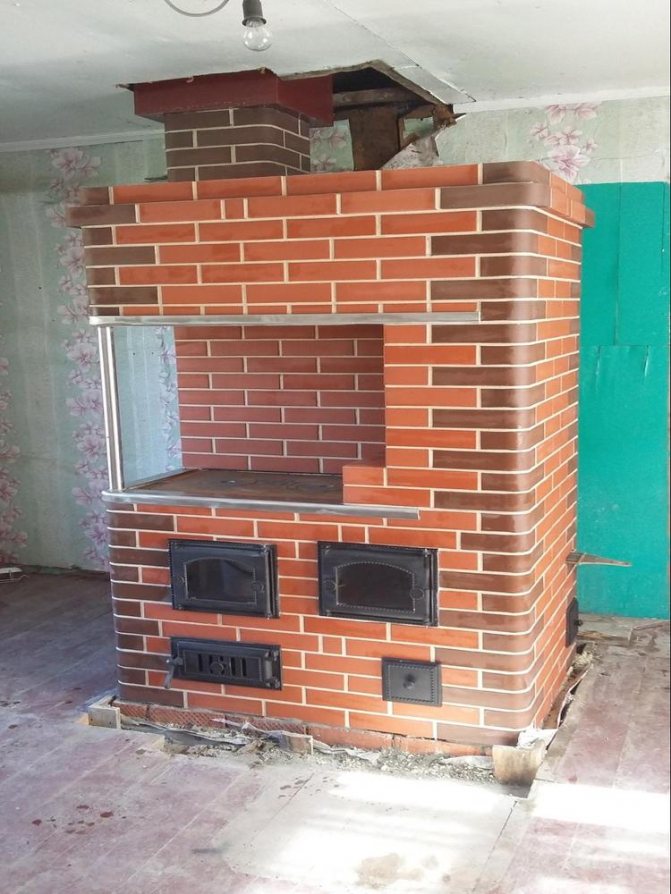
A significant disadvantage is the high cost of masonry due to the use of fireclay bricks. In addition, a significant part of the heat escapes through the lower part. This can be avoided if you spend money on thermal insulation.
Bell furnaces
They appeared relatively recently, but have already gained popularity due to their uniform heating and ability to retain heat for a long time. The main difference from all the previously listed options is the lack of channels.
When wood or coal is burned, smoke rises to the top of the dome. Here it slowly cools and falls down along the walls, warming them up. The internal space can consist of dozens of individual vaults, which significantly increases the efficiency of the equipment.
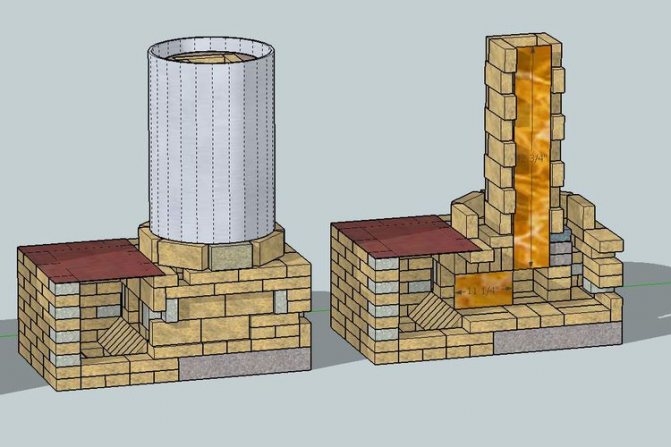
Bell-type structures are characterized by minimal masonry costs and the ability to quickly warm up, including in winter. The gas view will not allow the structure to cool quickly when the damper is open. The original version does not have a hob, but if necessary, it is quite easy to build it in.
Types of furnaces
English fireplace
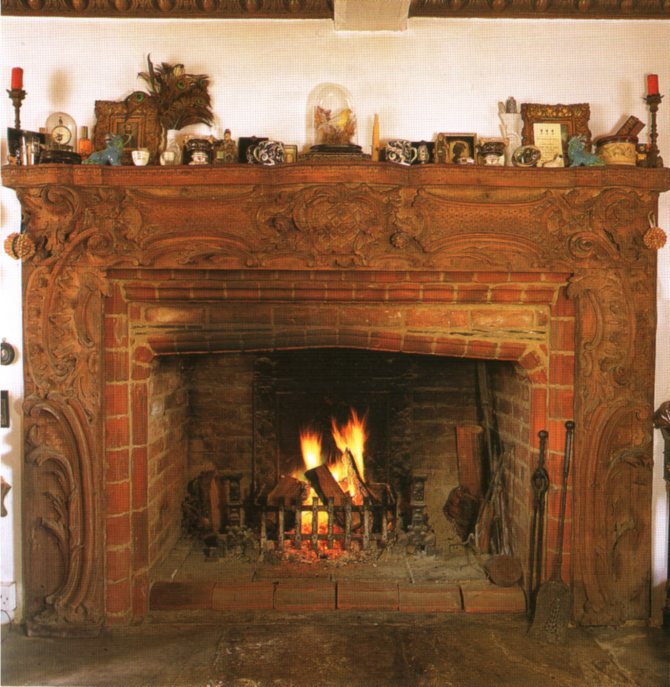
This heating design acquired its name solely because of some features inherent specifically to English fireplaces. The portal of the building is decorated in English style.
A distinctive feature of this stove is its open hearth. The side walls of the fuel chamber are turned towards the room, and the rear wall is inclined. Inside the firebox there is a so-called fuel tooth - a ledge that prevents smoke.
Russian stove
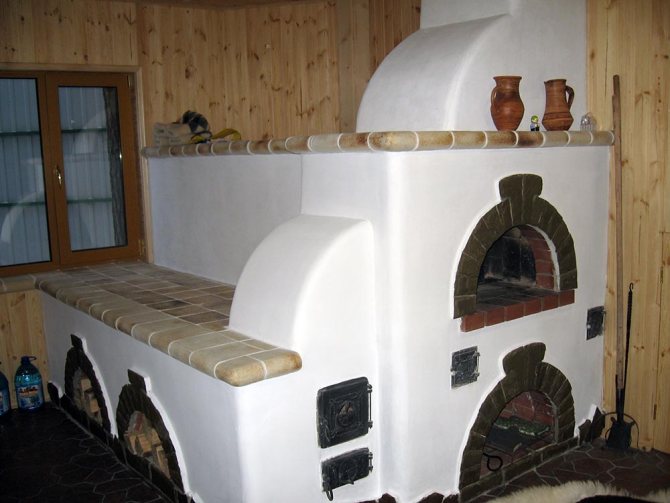
This design leads in the number of improvements and alterations. Entire generations of stove makers worked on its creation. The classic Russian stove has a crucible, which is both a combustion chamber and a cooking chamber. Firewood and food are placed into the furnace through the mouth. Hot air is trapped in the cooking chamber by the arch that separates the mouth and the furnace, and then enters the front of the firebox and exits into the chimney.
The disadvantages of the Russian stove are:
- low efficiency (no more than 70%);
- uneven heating of the room. The air at the top heats up faster than at the bottom;
- large dimensions;
- low heat transfer;
- long startup after inactivity. If you don’t use the stove in the summer, then in the fall you will need to heat it for at least a day to warm up the room.
The advantages of this design include versatility and the ability to operate on any solid fuel.
Dutch
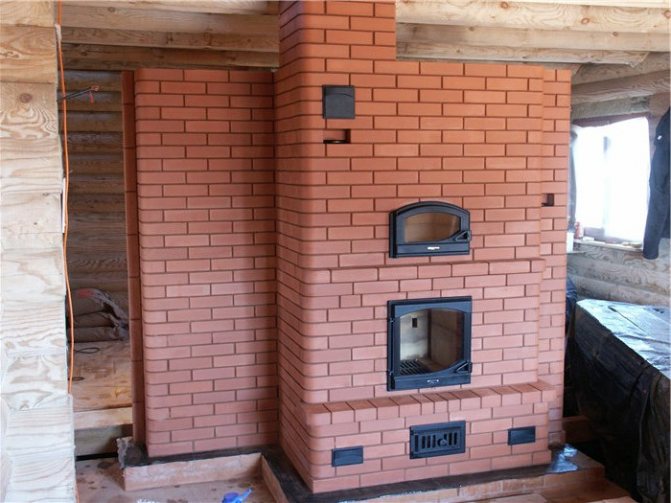
Dutch ovens have a rectangular shape and a single-channel straight chimney. During the reign of Peter 1, such structures were installed only in the houses of rich people. Subsequently, the Dutch were supplanted by central heating systems.
In the last century, similar structures were built at dachas and country houses. Nowadays such stoves are used only to give a special touch to the interior.
Dutch ovens are almost unsuitable for heating, since their efficiency does not exceed 40%. But, despite this, stoves have a number of advantages that attract both home owners and craftsmen:
- simplicity of design;
- possibility of modification;
- different sizes. If necessary, the firebox can be reduced to 50 square centimeters;
- low cost;
- the ability to increase the length of the chimney;
- fast heating;
- high heat transfer.
We recommend: Chimney for a gas boiler in a private house
Design disadvantages, in addition to low efficiency, include:
- risk of smoke due to excessive fuel consumption;
- sensitivity to fuel quality;
- fire hazard due to increased soot formation.
Swede
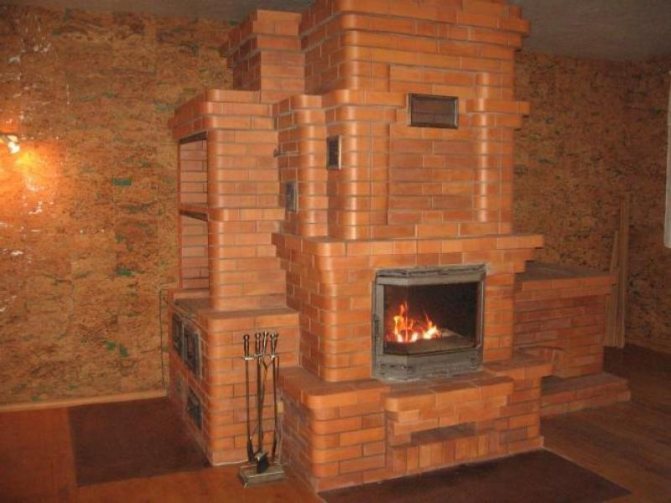
The Swedish oven is a modernized version of the Dutch oven. Because of its characteristics, it was singled out as a separate type of design.
The oven is designed to operate in harsh cold climates. Its main purpose is to quickly heat up and maintain heat in the room for a long time. In addition, the design should serve both for cooking and drying clothes.
Swedish stoves were originally installed in ozotnik houses. The chimney in this design is located in the rear part, which is called the shield and has a winding chimney. Due to the bends, smoke moves through it for a long time, which increases heat transfer.
Depending on the cross-section of the chimney, three types of Swedish stoves can be distinguished:
- with a vertical chimney;
- with a horizontal chimney;
- with caps.
Long burning stoves
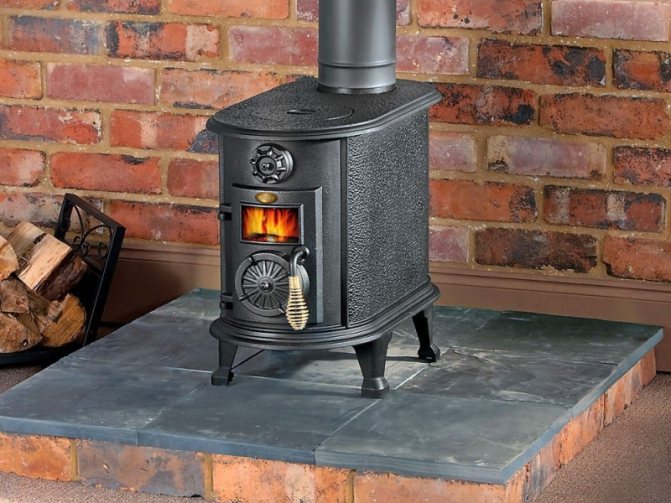
An ordinary stove, no matter what design it has, is distinguished by the fact that the fuel burns out in about 2-3 hours. The room warms up quickly, but after the fire stops, it cools down just as quickly.
A conventional stove takes oxygen into the room, a large amount of heat goes into the chimney in the literal sense of the word, and firewood must be added frequently, which is inconvenient at night.
Long-burning stoves are made of metal - cast iron or steel. Their design is different from ordinary ones. The combustion chamber is more spacious and is divided into two parts. The main feature of long-burning stoves is the ability to operate in two modes:
The long-burning mode involves slow combustion of fuel with a small volume of oxygen. The temperature in this mode is maintained constant. The firewood does not burn, but smolders, gradually giving off heat to the structure itself and the room;
intensive combustion mode. This is the normal operating mode for any other oven. The efficiency in this mode is very low. The advantage of a long-burning stove is the ability to switch from one mode to another without stopping the fire.
Types of furnace equipment for gas movement
The brick warms up well and releases energy into the surrounding space for a long time. But this is not enough for high-quality heating of the kitchen or bedrooms. The heat capacity is increased due to the arrangement of special chambers that promote heating of the walls.
Without going into technical details, the movement of smoke through special channels occurs as follows:
- During the combustion of wood or coal, gases are formed that have an extremely high temperature. Under the influence of physical laws, they rise upward, but are delayed due to obstacles in the form of jumpers and valves;
- smoke begins to spread through the flues, heating the walls;
- the temperature of combustion products decreases. They go into the outlet pipe.
If the channels are laid horizontally, less time is spent on cooling than in analogues with vertical ones. The reason is the low air speed. The inevitable consequence is uneven heating of the rooms.

If we analyze all existing types of stoves, it is preferable to choose units with chimneys laid from the bottom up. No additional effort is required to move the gas. They inevitably move upward and warm up the surrounding space.
But equipment with a vertical chimney is not without its drawbacks. If, in the presence of horizontal channels, the space around the firebox warms up more, then here the heat accumulates in the upper part. The first option is more consistent with fire safety standards.
Another important point concerns furnaces with vertical channels. They should not be too long. The gas passing through them will cool down greatly. The result is uneven heating.
In bell-type heaters, it was possible to partially eliminate the disadvantages associated with heat distribution. Here, separate outlets open into a single chamber. The smoke passes through small-diameter holes and is collected in a hood under the upper ceiling. The combustion products partially cool and fall down. Then they rush into the atmosphere, obeying the natural forces of nature.
In terms of heat capacity, bell-type units are better than their analogues. They are chosen when it comes to heating a house of a large area. If you need to heat a small building at the dacha, a Dutch or Swedish one is enough.
In this article we will consider options for heating stoves made of brick.
From the very name heating stoves, it becomes clear that these stoves are designed for heating premises, both residential and non-residential (garage, hangar, greenhouse, etc.).
The variety of such stoves is great and they differ primarily in the internal structure of the smoke channels. 1. Oven with horizontal channels.

In such a system, a cleaning door must be installed on each horizontal channel to remove ash and soot that settles on the horizontal surface of the channels. In such a stove, hot gases do not linger in the stove itself, but give off heat only as they move towards the chimney.

In this furnace design, there are thermal pockets in the channels in which heat accumulates. The average cross-section of the channel along its entire length became larger, which led to a decrease in the speed of gas movement. At a lower speed of gas movement, heat transfer from hot gases to the body of the furnace itself increases. This furnace design has a higher heat capacity and, accordingly, higher efficiency.
2. Oven with vertical channels.

Such a system of channels creates greater resistance to the movement of gases, which is both a plus and a minus of this system. The downside is that you need a higher chimney to draw gases through the stove channels. Plus, such a stove is less likely to blow out due to greater resistance in the channels. Accordingly, this system is more heat-intensive than the first option. The second drawback is overheating of the first channel, and as a consequence the occurrence of serious internal stresses. (read: cracking of the furnace body masonry).
3 Counterflow oven.

This system differs from the system with vertical channels (version 2) in that the lower channel in it is wider. This leads to the fact that the speed of gas movement in it decreases and the heat exchange between hot gases and the walls of the furnace itself increases. This option is more preferable than option 2.
4 Bell furnace.

This system is designed on the principle of free movement of gases. There are no thermal channels through which gases move, but there is a hood. Hot gases, rising to the top, cool down (giving up their heat to the stove) and go down and out into the chimney. After all the wood in the stove burns, hot gases remain in the hood and continue to give off their heat. Such a stove does not require a high chimney. Such a stove is practically not blown out. The cap or caps can be of different shapes and sizes, which allows you to make an oven of any shape and size. In bell furnaces you can use any fuel – even gas and electric heaters. Bell furnaces have higher efficiency and are more economical. This system is more profitable than options 1 2 3
The use of combined smoke circulation systems in furnaces is allowed. There are different combinations and there are a lot of them. When designing, it is possible to combine vertical, horizontal turns and caps in different versions.

As an example, a combination of horizontal channels with a counterflow system.
There is also a direct flow system.

Such a system is not suitable for a heating stove, but is suitable for fireplaces, barbecues, Russian stoves and, in some cases, for sauna stoves. You can, of course, improve this scheme by adding a thermal load with cuts to it

But still, such a system is not suitable for heating a room.
Brick kiln performance
The task of any stove is to compensate for heat loss during the cold season. Cooking food and drying things are additional, albeit important functions. But when calculating power they are practically not taken into account.
The main parameter is the thermal characteristics of the building. To calculate them, energy losses through the floor, walls, ceiling, doors and windows are added up. If the building has ventilation ducts, they must be taken into account. The productivity of a Dutch or Swedish woman should exceed the obtained value by 10-15%. Otherwise it will be cold in winter.
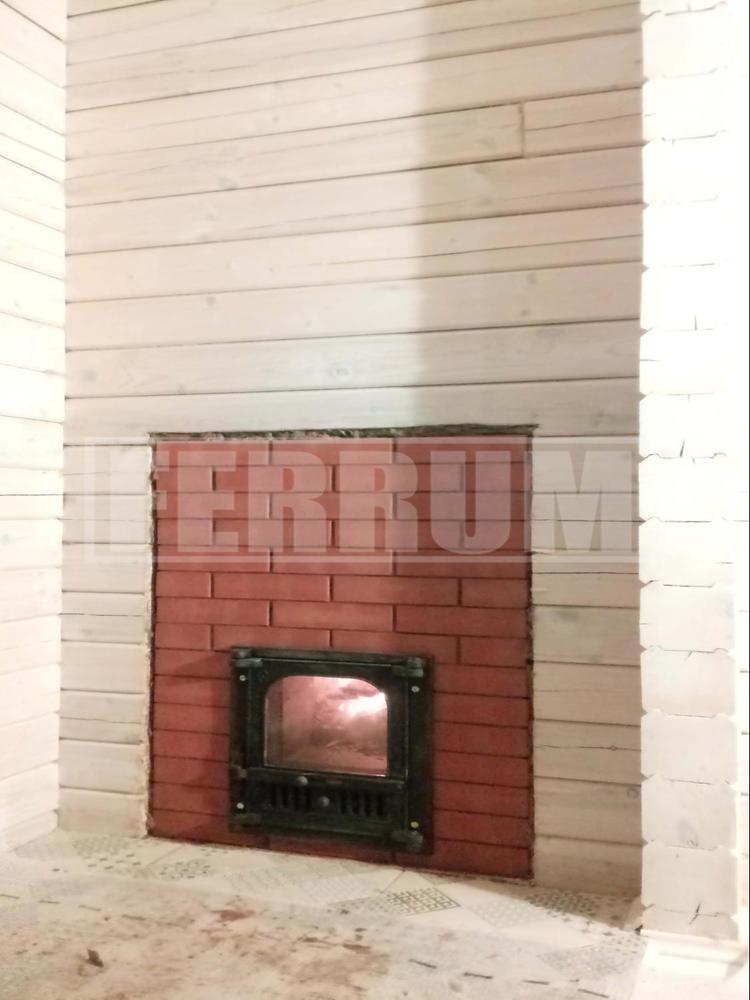
During the use of stoves for a red brick house (pictured), the interdependencies between the area of a separate room and heat loss under different conditions, for example, in the presence of only one or two external walls, were experimentally established.
In the second case, the calculations become more complicated, since the height of the ceiling is taken into account. If the surfaces of the firebox face the rooms and are closed, correction factors are used. They allow you to correct the data.
What types of brick kilns are there?
But still, first of all, it is necessary to decide on the purpose of the stove, respectively, on its type:
- heating option (“Dutch”);
- heating and cooking configuration (famous Russian stove, stove with oven and heating plate, “Swedish” stoves, etc.);
- just a cooking stove (kitchen hearth, outdoor barbecue, cauldron stove);
- special narrowly targeted stove (heater stove for a bath, greenhouse stove, water heating boiler, garage stove, etc.).
For a summer residence, the heating option of a stove or a heating and cooking stove is preferably chosen. The second option is also equipped with a hob and, if necessary, an oven – an “oven”. And lovers of a quiet pastime contemplating an open fire should think about building a fireplace.
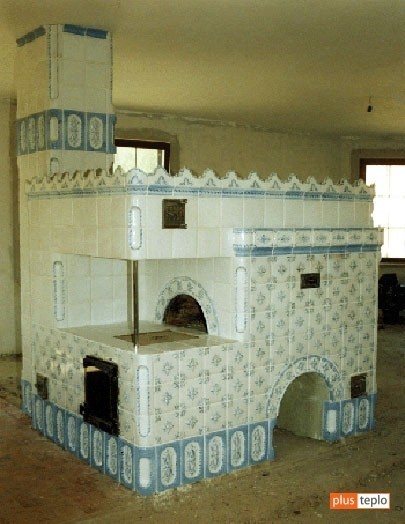
Russian stove
Note! Fireplaces, as sources of heat, primarily transmit it to us by radiation. Therefore, we feel the heat immediately after it is kindled, but it will not be possible to retain the heat for a long time in a direct-flow fireplace.
According to their form they are divided into:
- rectangular;
- square;
- corner;
- round;
- T-like.
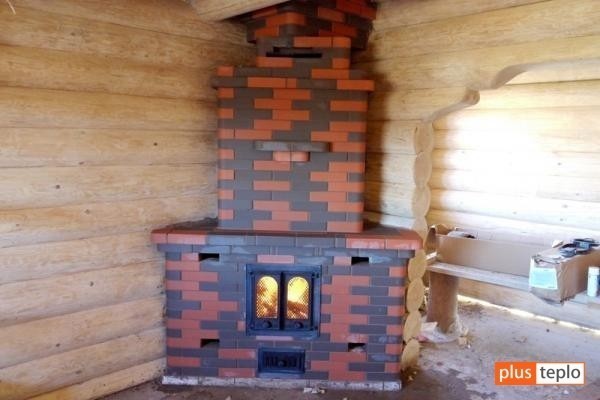
The heat transfer parameters of stoves also depend on the thickness of their walls. There are:
- thin-walled;
- thick-walled;
- combined.
Furnaces are subjected to four main types of external finishing:
- brick “for jointing”;
- plastered stove;
- tying with stove tiles, tiles;
- “dressed” in a metal case.
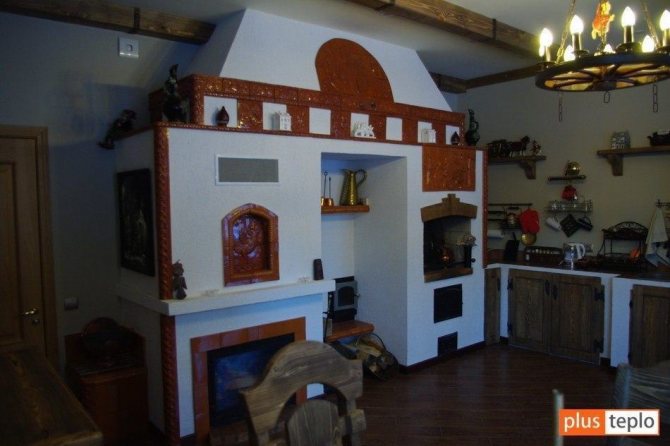
Plastered stove
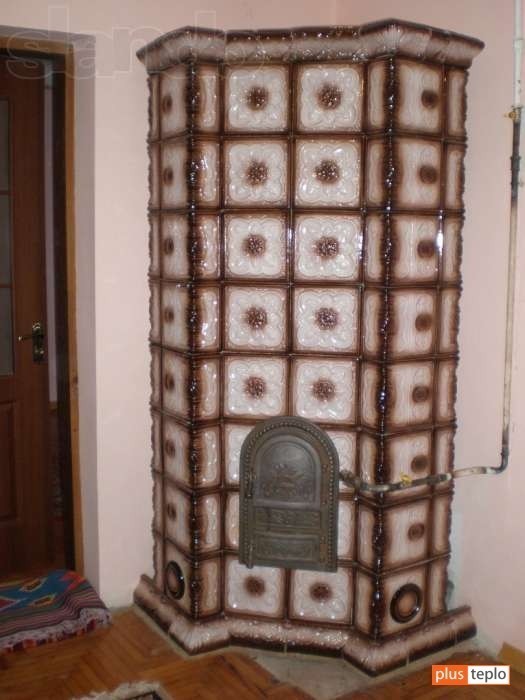
Tiled stove
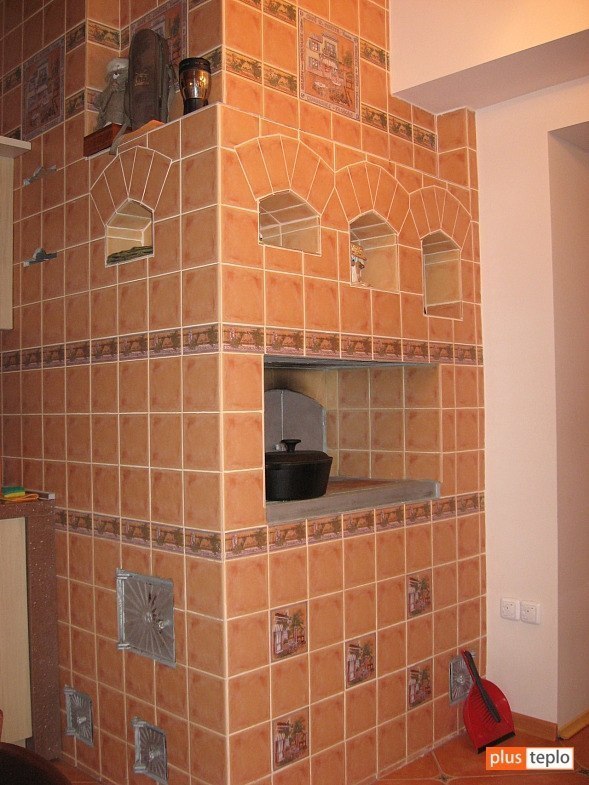
Regarding the structure of the chimney channels, stoves are distinguished:
- direct-flow or counter-flow;
- with horizontal or vertical channels;
- single-turn or multi-turn;
- ductless;
- with bottom heating.
How often should you light the stove?
Taking into account how often fuel has to be loaded, all units belong to one of the groups listed below:
- periodic action. Firewood or coal is added from time to time. The combustion temperature can reach 1000 0C. To avoid fire and premature destruction of the structure, the wall thickness should start from ¾ brick;
- continuous burning. Heat is not accumulated. The density of the walls does not exceed ½ stone. The firebox is of shaft type. In the standard version, firewood smolders for up to a day. Energy is released evenly, in relatively small portions.
The second type of firebox requires large volumes of oxygen to operate. They are recommended for homes with permanent residence. At dachas and cottages used only on weekends, it is better to choose designs with periodic action.
In relation to the previously discussed types of equipment, the following must be indicated:
- Russian stove. During the cold season it is heated continuously. The body should not cool down. Otherwise, condensation will accumulate in the channels. The brick gets wet and cracks during subsequent ignition. In the summer months, by moving the valves, the fumes from the firebox are directed directly into the chimney. There is no heating effect;
- Dutch. After ignition, it warms up in a few minutes. But it cools down just as quickly if you don’t close the view in time. Recommended operating mode: continuous smoldering;
- Swede. In winter, it cannot be cooled completely due to accumulating condensation. The masonry can completely collapse within a few months;
- bell-shaped Operation in any mode is allowed. Warm up in a few minutes.
How to choose a stove for a red brick house - photo
If we are talking not only about heating, but also about complementing the interior, you can give preference to a round Irish stove. The thickness of the walls is ¼ stone. To give additional strength and increase heat transfer, a metal frame is “put on top”. It will strengthen the masonry and allow you to decorate the outer surfaces with forging.
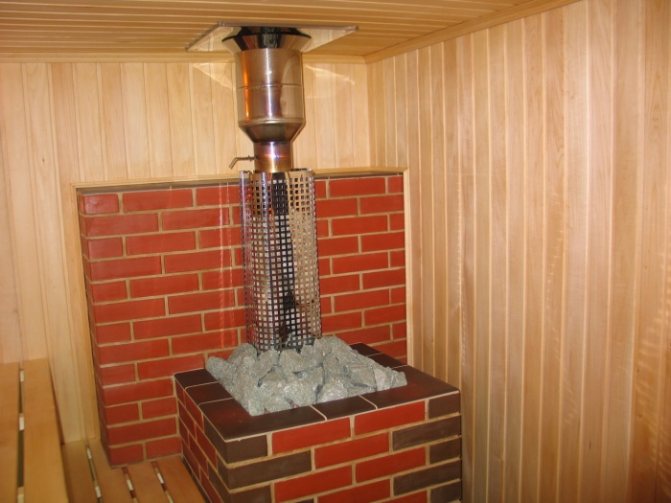
If there are always people in the building, and there is a desire to cook food on wood or coal, you should choose a square or rectangular design, for example, Russian or Swedish. If you need a fireplace more as a stove for your home, pay attention to thin-walled Dutch or round Irish stoves. They are ideal if you don't need a special cooktop. And the front surface can be decorated with elegant tiles. They can become both an addition to the interior.
Do you want to stop using a gas stove? Variations of the Swede are at your service. They will warm you up and allow you to brew coffee over an open flame. The main thing is to correctly lay out and select the source materials.
Where to place the stove in the house
The main focus is on the design phase. The quality of the drawings determines the safety, performance properties, and aesthetic appeal of heating equipment. If you don’t have your own drawing skills, it’s better to turn to professionals. When choosing a place for placement, both the type of heater itself and the area of the cottage or part of it that is planned to be heated are taken into account.
Selection of working tools
Then you can move on to the tools. For work you will need:
- jointing With its help, concrete is poured into the seams;
- trowel;
- pick;
- shovel for mixing and supplying the solution;
- special line.
Materials
The next stage is purchasing the material. The heat transfer of the stove and its durability will depend on the quality of the brick. The rules are as follows:
- the outer surface is made of brick (grade M-500). They do not crack, do not lose their consumer properties during periodic heating or cooling;
- Only refractory bricks are suitable for the combustion chamber.
In addition, you will need sifted sand and high-quality clay.
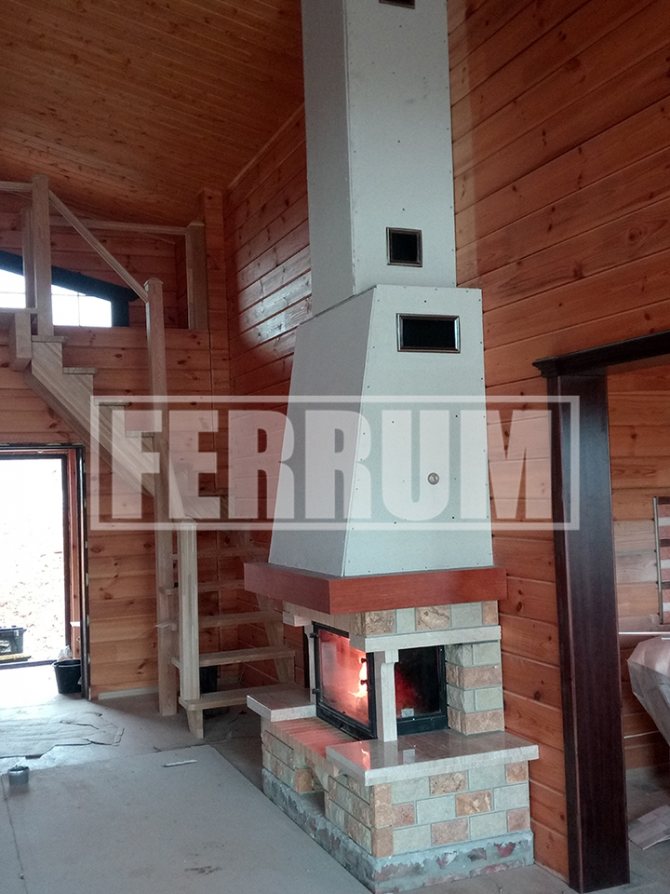
Laying the foundation
Materials have been purchased. You can move on to the construction stage. It is important to understand that the stove must stand on a strong and high-quality foundation. It is better to lay it at the same time as the base of the entire house.
If the decision to build a Dutch or Swedish one is made only now, you will have to:
- dig a hole. On each side there should be at least 20 cm to the walls;
- level the bottom and fill it with sand, followed by thorough compaction;
- lay a waterproofing membrane;
- install formwork;
- pour concrete (1 part cement x 2.5 parts sand x 4 parts small crushed stone) to ground level. The surface of the foundation must be strictly horizontal;
- wait 5-6 days for the concrete to harden. After this, you can disassemble the formwork and lay waterproofing.
If, as a result, the foundation ends up below the floor level, it is leveled by additional pouring of concrete mixture. In the latter case, the formwork is rebuilt. The entire space around the foundation is filled with soil and thoroughly compacted.
Masonry process
First, a mixture of sand and clay, previously soaked, is prepared. It fills the gaps between the outer and inner walls. They are displayed separately, but there should be no spaces between them. The lowest rows are only made of solid brick and with a sling. Then the brick is cut taking into account the selected modification. The chopped side faces the inside of the masonry. To build a chimney you will need red burnt stones. Knowing the “castle” layout will not be superfluous. A brick chimney must be lined with a FERRUM stainless steel chimney to prevent the formation of condensation and premature destruction.
Is the oven built? There is no need to rush to melt it. You must wait at least 3 weeks.
Connecting elements
They allow you to organize the supply of air necessary for combustion and control draft.
Facing
The external design of the stove is inseparable from its design. Often the brick or cast iron from which the stove is made is also its lining. A brick oven can be plastered or tiled. Nowadays, tiled stoves are experiencing a revival, as they provide the opportunity to use, in addition to the tiles themselves, many decorative elements: columns, kokoshniks, relief inserts.
In the photo: model 10 from the Gutbrod Keramik factory.
- The grate is a grate on which fuel is placed. It is inserted into the base of the firebox. Air necessary for uniform combustion enters the firebox through the grate.
- The blower is an air intake channel that corresponds to the draft. Located in the lower part of the oven, it supplies air to the grate.
- Ash pit is a chamber or box under the grate where ash spills. Often serves as a blower.
- The damper (valve, gate) is installed at the transition point from the heat exchange part of the chimney to the pipe. By pulling it out or pushing it in, you can control the intensity of the thrust. Once combustion is complete, the damper must be pushed in to block the chimney and prevent drafts and rapid cooling of the stove.
The article uses images from the site 360.ru
Three options for laying a stove with orders
Below is information regarding the construction of the main body of heating equipment. Laying the foundation is discussed in detail in the previous paragraph of this article. The most popular modifications are selected as examples.
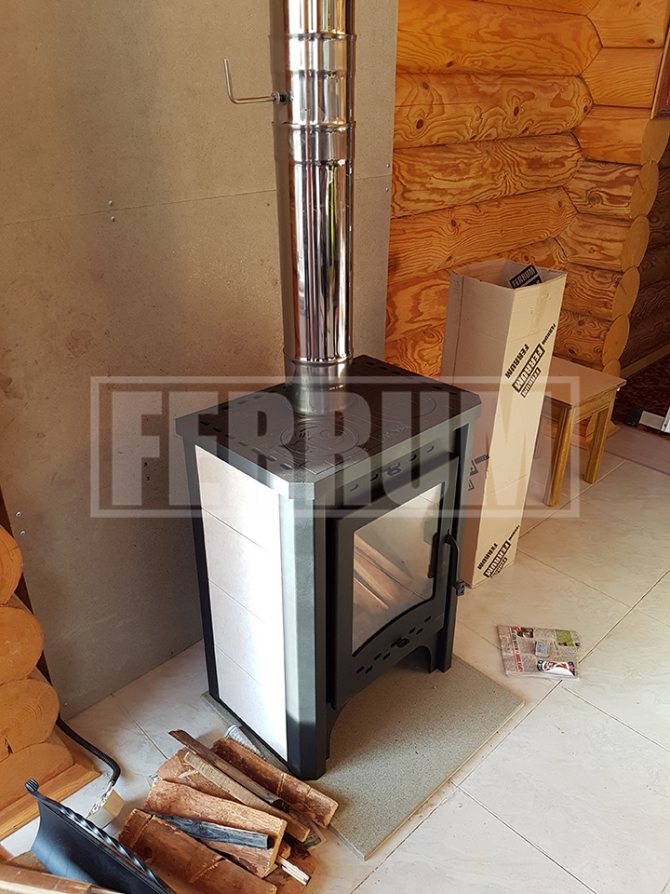
Russian with a high bed
Settles in regions with cold and temperate climates. It is heated once/twice a day.
Below are descriptions of the rows:
- The first should be continuous using cement or lime mortar.
- Starting from the 2nd to the 4th, they begin to build a semblance of a well. On the front side there is a hole for baking. A prerequisite is the presence of a dressing.
- 5th - beginning of the arch. To lay it out, you will need shaped formwork, and the heels of the bricks will have to be pulled off. The operation continues in lines 6 and 7. In the 8th the vault closes.
- Rows 8 to 10 are laid out in one stone. At 11, the cold stove turns off. A layer of sand is poured on top. It should slope towards the rear.
- In the 12th, a continuous surface of refractory stone is laid out over the poured sand. This part of the firebox will be in direct contact with the fire. It is desirable that the floor is perfectly level. Does not work? You can add sand and sand the outer surface.
- Rows 13 to 16 are a crucible. Blocks - 3/4, with a sling. No masonry mortar is required at this stage. To make castles, the stones are cut to 450.
- Starting from the 17th line, the mouth and posterior surface are formed. The cooking chamber is being built. A brick with hewn heels is placed on its edge.
- 18th. The furnace walls are laid out. To fill the free space between the individual chambers you will need sand. You can add cut heels to it.
- 19th - laying out the vaulted opening above the pole. Behind it is the mouth.
- 20th - the walls are leveled. The hole above the pole is reduced. A cross-pipe is formed.
- The 21st row is no different from the 19th.
- 22nd - the vault closes. On the right is a chamber in which soot will accumulate. The view is also located here. With its help, the chimney is blocked so that the heat does not escape into the atmosphere too quickly.
- Lines 22 to 32 - laying out the overpipe, laying the view and building a chimney channel. The cross-section of the latter is 26x26 cm.
After this, all that remains is to remove the outer pipe and mount an additional damper. It will require a steel corner or strip 3 mm thick.
Semicircular chambers can be replaced with ordinary rectangular ones.
Improved "Teplushka"
All brick ovens have one common drawback - the walls heat up unevenly. Builders are trying to solve this problem by introducing changes to the design. This is how “Teplushka” appeared. After fuel combustion, part of the gas leaves the house immediately through the chimney. The remainder goes into the channels and is intended for space heating.
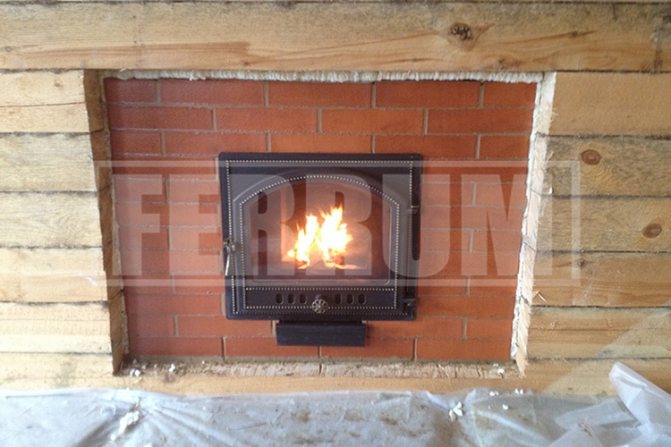
Heat transfer in comparison with the classic Russian modification increases immediately by 2.5 times. Structurally, “Teplushka” is closer to its bell-type analogues. The chamber is divided into 2 parts: food is prepared in the upper part, fuel is burned in the lower part. The floor itself is supported by pre-installed posts. Additionally, there are 4 openings on the sides to allow combustion products to pass through. The minimum chimney height is 5 meters. The countdown is from the bottom of the firebox.
The main differences from the traditional version are the displacement of the channel relative to the firebox. To remove cooled gas, special holes are laid at the bottom of the channel.
Important! The damper must be closed during cooking. You can use a special peephole.
The orders for the "Teplushka" are presented in numerous diagrams. The main requirement is that to increase heat transfer, the ceiling installed in line 21 is carefully covered with a mixture of sand and debris.
Simple stove with shield
This option is for those who want to build a stove at their dacha or in a small country cottage (no more than 20 square meters) with minimal costs, including temporary ones. The firebox is made of fireclay clinker, optionally red solid (provided that only coal will be used as fuel).
Cooking and burning fuel are in separate chambers. Gases pass through the cooking chamber and pass into the chimney. Photos of brick stoves for the home allow you to see in detail all the necessary masonry sections.
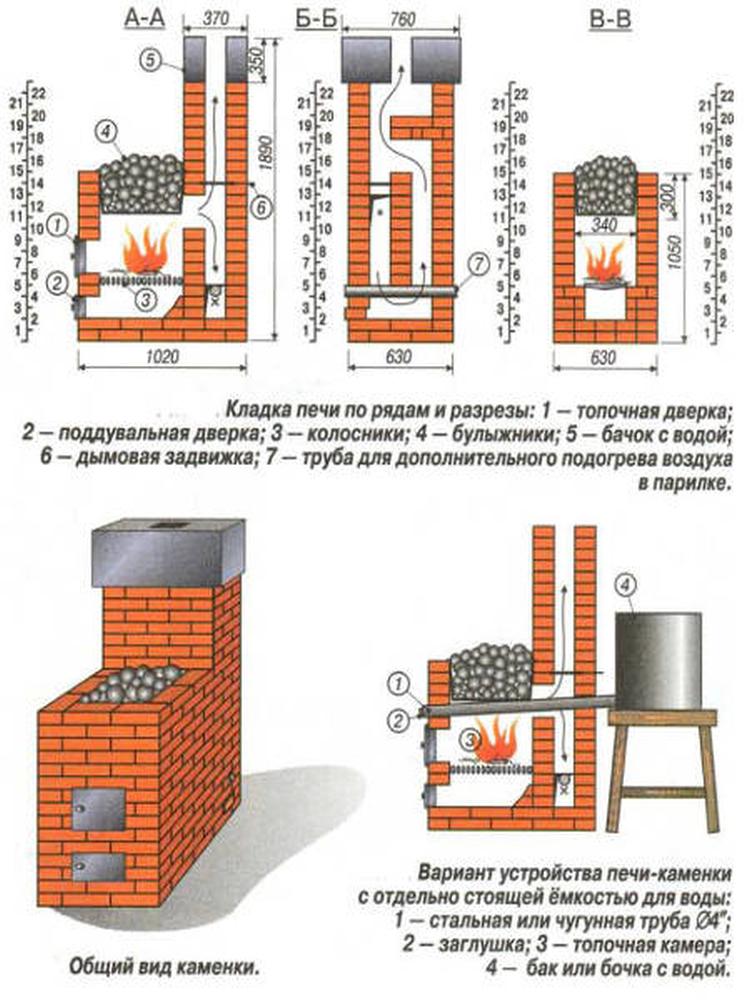
A horizontal channel is installed at the very bottom. Thanks to it, the air near the foundation warms up well. A microclimate favorable for humans is created in the room.
Advantages of a brick kiln
The main advantage of Swedes and bell-shaped variations is their heat capacity. If you choose the right place for placement and lay it out without errors, you can maintain a comfortable temperature in 4 rooms at once using one device.
Additional advantages include:
- independence from central heating;
- environmental cleanliness. If you don’t throw plastic yogurt jars into the firebox, a minimum of harmful substances will be released into the atmosphere;
- unpretentiousness in care and maintenance;
- the ability to choose a completely unique exterior design.
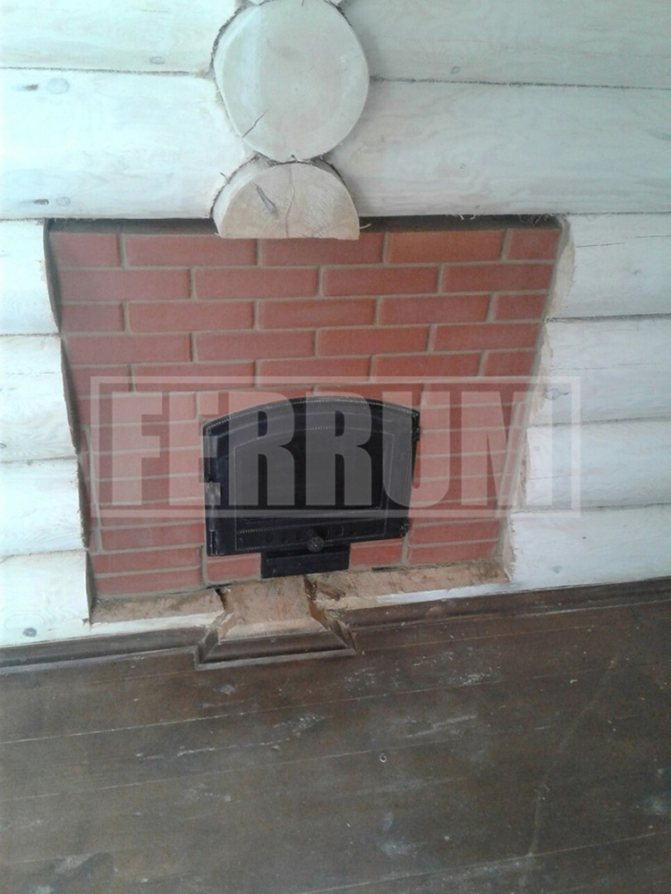
Another important aspect is the creation of a favorable microclimate in the rooms. The air does not dry out, and the walls warm up well.
Tips from the professionals
A brick stove in a wooden house will create an aura of warmth and comfort - interior photos confirm this. But its masonry should be treated with special attention.
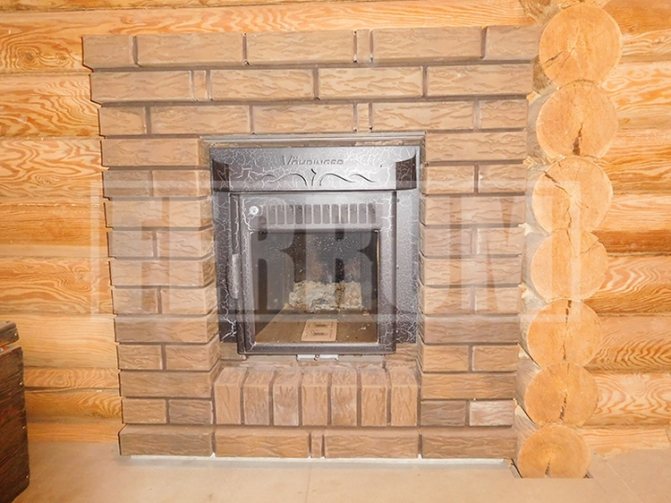
On specialized websites, experts and amateurs share their experiences and present ordering schemes. You can also find plenty of finishing tips.
To summarize the most frequently encountered recommendations, we can highlight the following:
- special attention to the dressing and thickness of the seams. The last parameter must be the same throughout the array;
- brick blocks are pre-soaked in water;
- for cutting you will need a grinder with diamond wheels;
- In the smoke ducts on the walls, no cement should be visible from the seams.
Main advice: if you have no experience in construction work at all, it is better to initially contact a specialized company.
Bell system
Bell-type brick furnaces are based on the principle of free movement of gases under the influence of gravity. Inside the structure there is a kind of cap, where incoming gases rise upward and transfer thermal energy to the brickwork. As they cool down, they gradually descend and exit into the chimney.
This type of stove has many advantages over tunnel options:
- Even after the fuel has finished burning in the stove, there remains enough hot air under the hood, which gives off heat for a long time.
- In this design there is no need for a high chimney.
- Heat is not blown away in strong winds.
- You can build a product of any shape and size.
- This design is suitable for stoves operating on various types of fuel.
- The efficiency of such stoves is much higher than that of other gas outlet systems.
- These models are more economical in terms of fuel consumption.
- This design produces a small amount of soot, so it does not require frequent cleaning.
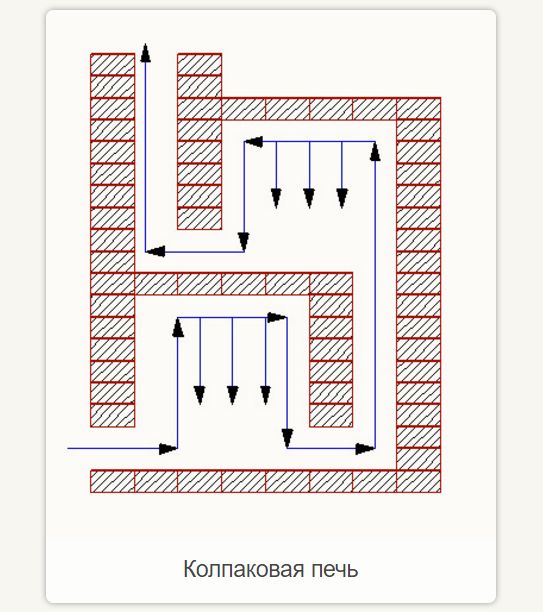
Double-bell brick kilns have greater efficiency
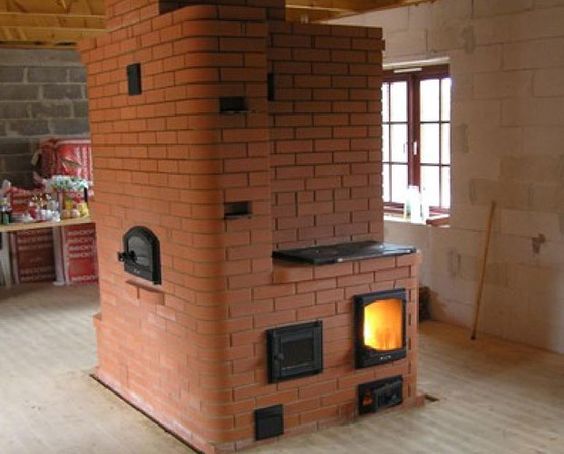
Kuznetsov's brick stove is suitable for any room
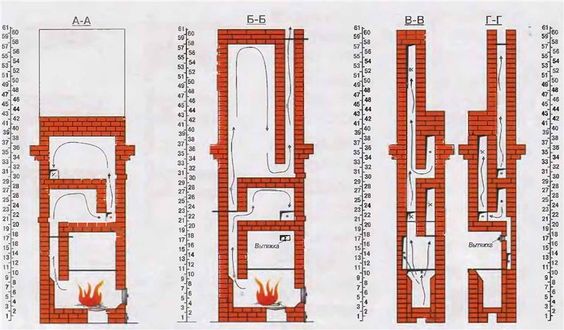
Several bell-type stoves can be made. Thus, the heat transfer of gases will be significantly higher. There are several types of such furnaces, but they all work on the same principle. A two-bell brick stove is a very efficient heater.

